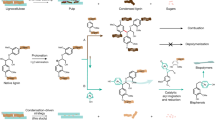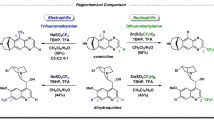Abstract
MICROBIOLOGICAL reductions of α-keto-groups have been reported by Neuberg et al.1. Lemieux and Giquere2 carried out reductions of β-keto-caproic and β-keto-caprylic acids. Microbiological reductions of γ- and δ-keto-acids to yield optically active lactones have so far not been described in the literature.
This is a preview of subscription content, access via your institution
Access options
Subscribe to this journal
Receive 51 print issues and online access
$199.00 per year
only $3.90 per issue
Buy this article
- Purchase on Springer Link
- Instant access to full article PDF
Prices may be subject to local taxes which are calculated during checkout
Similar content being viewed by others
References
Neuberg, C., and Gorr, G., Biochem. Z., 154, 495 (1925).
Lemieux, R. U., and Giquere, J., Canad J. Chem., 29, 678 (1951).
Unilever, N. V., Belgian Pat. 592,593.
Author information
Authors and Affiliations
Rights and permissions
About this article
Cite this article
MUYS, G., VAN DER VEN, B. & DE JONGE, A. Synthesis of Optically Active γ- and δ-Lactones by Microbiological Reduction. Nature 194, 995–996 (1962). https://doi.org/10.1038/194995b0
Issue Date:
DOI: https://doi.org/10.1038/194995b0
This article is cited by
-
The absolute configuration of (+)- and (−)-1-phenylundec-4-yn-3-ols. Synthesis of (R)-4-dodecanolide, a component of the defensive secretion of rove beetle Bledius mandibullaris
Russian Chemical Bulletin (2013)
-
γ-Heptalactone is an endogenously produced quorum-sensing molecule regulating growth and secondary metabolite production by Aspergillus nidulans
Applied Microbiology and Biotechnology (2012)
-
Twenty‐five years of flavor research in a food industry
Journal of the American Oil Chemists' Society (1977)
-
Δ‐and E‐hydroxylation of keto acid by mushrooms
Lipids (1974)
-
Optical activity of lactones from animal and vegetable fats
Journal of the American Oil Chemists' Society (1970)
Comments
By submitting a comment you agree to abide by our Terms and Community Guidelines. If you find something abusive or that does not comply with our terms or guidelines please flag it as inappropriate.



